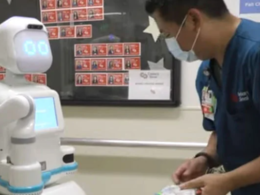the health strategist
institute for strategic health transformation
& digital technology
Joaquim Cardoso MSc.
Chief Research and Strategy Officer (CRSO),
Chief Editor and Senior Advisor
November 7, 2023
One page summary
What is the message?
The nursing crisis, characterized by high levels of job dissatisfaction and burnout among nurses, is a significant concern in the healthcare industry.
To combat this crisis, healthcare leaders must actively listen to nurses, analyze their feedback, and take actions to address the root causes of dissatisfaction.
The article emphasizes the importance of understanding the specific challenges faced by nurses, including issues related to compensation, workload, toxic culture, organizational support, work schedules, communication, and learning and development opportunities.
It also highlights the value of feedback from former employees and draws lessons from staffing agencies that excel in problem-solving and communication.
Overall, the message is that healthcare leaders can mitigate the nursing crisis by proactively addressing these concerns, thereby improving job satisfaction and retention in the nursing workforce.

What are the key points?
Nursing Crisis Overview:
The healthcare industry is grappling with staff shortages and burnout, with 90% of hospital CEOs identifying nursing shortages as a significant concern.
The US witnessed a significant drop in the number of registered nurses in 2021, primarily affecting younger nurses.
By 2025, the shortage could reach up to 450,000 nurses, which is 20% below the required workforce.
Factors Contributing to the Crisis:
Job dissatisfaction and burnout among nurses have not improved since the COVID-19 pandemic. Dissatisfaction has even increased, with fewer nurses recommending the profession. The research analyzes 150,000 reviews written by US nurses on platforms like Glassdoor and Indeed, highlighting their key concerns.
Leadership Disconnect:
Nurses perceive their managers as out of touch with the daily realities of patient care. Over 50 leadership traits were identified, with the most frequently cited being managers’ unawareness of nurses’ challenges. Senior executives were viewed as the most disconnected, reinforcing nurses’ belief that management doesn’t listen to their concerns.
Varying Satisfaction Across Employers:
Nurse satisfaction varies significantly across healthcare employers, from poor to near-perfect ratings. Staffing agencies tend to have higher satisfaction, but it’s not solely due to compensation. Factors like problem-solving, communication, and quick resolution of issues also play a role in high satisfaction.
Key Predictors of Job Satisfaction:
Compensation and workload are the top predictors of nurse satisfaction, followed by aspects of the work environment, such as toxic culture, organizational support, work schedules, communication, and learning and development opportunities. These factors must be addressed to improve nurses’ job satisfaction.
Using Text Analytics for Insights:
Advanced text analytics can provide nuanced insights into the challenges nurses face by analyzing their feedback. This allows healthcare leaders to pinpoint specific issues and tailor interventions accordingly. Feedback from former employees is valuable and can uncover critical reasons for attrition.
Learning from Staffing Agencies:
Staffing agencies are notably good at resolving problems efficiently and maintaining open, honest communication. Healthcare systems can adopt similar practices to capture and analyze nurses’ feedback effectively. Listening to nurses and acting on their suggestions can build trust and improve job satisfaction.
Translating Feedback into Action:
Collecting feedback is essential, but consistently acting on these insights is equally important. Organizations must establish structures to ensure feedback leads to tangible improvements. Leveraging feedback to identify and prioritize opportunities for improvement can significantly enhance employee satisfaction.
Statistics
- In 2021, the US experienced the largest drop in registered nurses in 40 years.
- By 2025, the US healthcare system could face a shortage of up to 450,000 nurses, representing a 20% shortfall.
- Nurse satisfaction varies widely among healthcare employers, with ratings ranging from poor (2.6) to nearly perfect (4.9) on a 5-point scale.
- Among nurses who quit, toxic culture is more than twice as predictive of overall satisfaction compared to compensation or workload.
- Over one-third of Glassdoor reviews in the study were written by former employees, providing valuable insights into attrition reasons.
Examples
- Leadership Disconnect: Nurses often view senior executives as out of touch. Nearly half of hospital nurses believe that management does not listen to their concerns.
- Learning from Staffing Agencies: Staffing agencies excel in efficient problem-solving and open, honest communication. For instance, staffing agency nurses are positive about having the psychological safety to speak up about difficult issues.
- Translating Feedback into Action: Kaiser Permanente’s unit-based teams (UBTs) have successfully used employee feedback to identify and address improvement opportunities, leading to enhanced patient outcomes, employee satisfaction, and cost reduction.
Conclusion
The nursing crisis is a multifaceted challenge that requires a comprehensive approach. By actively listening to nurses, addressing their concerns, and implementing data-driven changes, healthcare leaders can create an environment where nurses look forward to their work, improving both patient care and the overall health of the healthcare industry.
The single most important step in addressing this crisis is to listen to those who experience it firsthand – the nurses themselves.
Infographic


DEEP DIVE

This summary was written based on the article “The Real Issues Driving the Nursing Crisis”, published by MIT Sloan Management Review and written by Donald Sull and Charles Sull, on Ocotber 18, 2023.
To read the original publication, click here.











